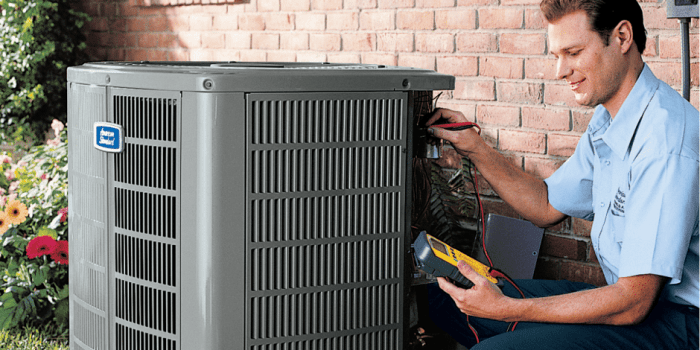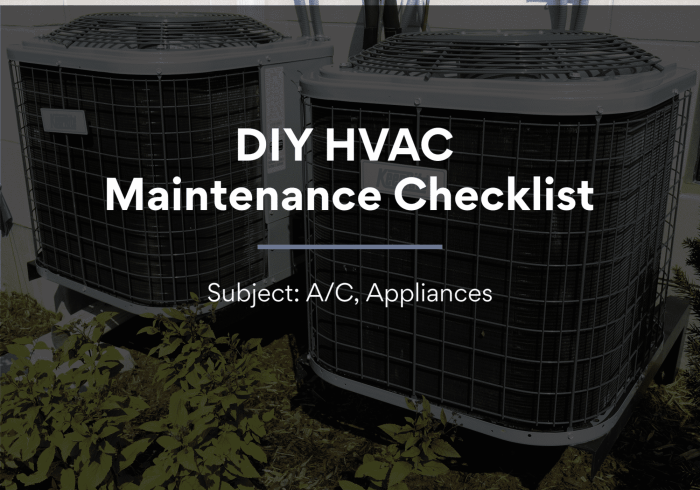Optimizing Central Air Maintenance for Efficiency
Central air maintenance is not just a task; it's a key ingredient in the recipe for a comfortable and energy-efficient home. From routine upkeep to professional services, every aspect plays a crucial role in ensuring your system operates at its best.
Let's dive into the world of central air maintenance to uncover the secrets to a cool and cost-effective environment.
As we explore the importance of regular maintenance, key components to focus on, DIY tips for homeowners, and the benefits of professional services, you'll gain valuable insights into maximizing the lifespan and performance of your central air system.
Importance of Central Air Maintenance

Regular maintenance of central air systems is crucial to ensure optimal performance and energy efficiency. Neglecting maintenance can lead to a variety of issues that can affect the overall functionality of the system.
Impact of Neglecting Maintenance
- Decreased efficiency: Dust and debris build-up can restrict airflow, causing the system to work harder and consume more energy.
- Reduced lifespan: Lack of maintenance can lead to premature wear and tear on components, shortening the overall lifespan of the system.
- Poor indoor air quality: Dirty filters and coils can result in poor air circulation and contribute to allergens and pollutants circulating in the indoor air.
Key Components of Central Air Maintenance
Regular maintenance of key components in a central air system is crucial to ensure optimal performance and longevity of the unit. Let's explore the essential components that require attention and care.
Cleaning Filters, Coils, and Ducts
Regular cleaning of filters, coils, and ducts is vital for the efficient operation of a central air system. Dirty filters can restrict airflow, reducing the system's efficiency and causing it to work harder, leading to higher energy consumption. Clogged coils can also hinder heat transfer, affecting the cooling capacity of the unit.
Additionally, dirty ducts can harbor dust, allergens, and mold, impacting indoor air quality. Therefore, cleaning these components regularly is essential for maintaining the system's performance and ensuring clean, healthy air circulation.
Inspecting Refrigerant Levels and Electrical Connections
Monitoring refrigerant levels is critical in central air maintenance to ensure proper cooling capacity. Low refrigerant levels can indicate a leak in the system, which needs to be addressed promptly to prevent damage to the compressor. Moreover, checking electrical connections is important to prevent overheating or electrical failures that can lead to system malfunctions or breakdowns.
Regular inspection of refrigerant levels and electrical connections helps in identifying potential issues early on and addressing them before they escalate, ensuring the smooth operation of the central air system.
DIY Maintenance Tips
Maintaining your central air system is crucial to ensure it operates efficiently and lasts for years to come. Here are some practical DIY maintenance tips to help you keep your system in top condition.
Cleaning or Replacing Air Filters
Air filters play a key role in maintaining good air quality and ensuring proper airflow in your central air system. Follow these steps to clean or replace your air filters:
- Turn off the power: Before starting, make sure to turn off the power to your central air system to prevent any accidents.
- Locate the air filter: Find the location of the air filter in your system, usually near the return air duct or the air handler.
- Remove the filter: Carefully remove the old filter from its slot, taking note of its size and type for replacement.
- Clean or replace: Depending on the type of filter, either clean it with a vacuum or water, or replace it with a new one if it is disposable.
- Install the filter: Place the cleaned or new filter back into its slot, ensuring it is securely in place.
- Turn on the power: Once the filter is back in place, turn the power back on and monitor the system for any changes in airflow or performance.
Keeping the Outdoor Unit Free from Debris and Vegetation
The outdoor unit of your central air system is exposed to the elements and can easily get clogged with debris or overgrown vegetation. Here's how you can keep it clean and free from obstructions:
- Inspect the unit: Regularly check the outdoor unit for any debris, leaves, or vegetation that may be blocking the airflow.
- Clean the area: Remove any debris or vegetation around the unit to ensure proper airflow and ventilation.
- Trim vegetation: Trim any bushes, plants, or trees near the outdoor unit to prevent them from obstructing the airflow or causing damage to the system.
- Clear the area: Make sure there is at least 2 feet of clearance around the unit to allow for proper air circulation and efficient operation.
- Protect the unit: Consider installing a cover or shade over the outdoor unit to shield it from direct sunlight and debris accumulation.
Professional Maintenance Services
When it comes to ensuring the optimal performance and longevity of your central air system, hiring professional HVAC technicians for maintenance services is crucial. These experts have the knowledge, skills, and tools to conduct thorough inspections, identify potential issues, and provide necessary repairs or adjustments.
Advantages of Scheduled Maintenance Programs vs. One-Time Service Calls
Scheduled maintenance programs offer several advantages over one-time service calls. With scheduled maintenance, technicians can regularly inspect and tune-up your system, ensuring that it operates efficiently and reducing the risk of unexpected breakdowns. Additionally, these programs often include priority service and discounts on repairs, helping you save money in the long run.
Typical Procedures in Professional Central Air Maintenance
- Inspection of the entire system, including the condenser unit, evaporator coil, ductwork, and air filters.
- Cleaning and lubrication of key components to ensure smooth operation and prevent wear and tear.
- Checking refrigerant levels and adjusting as needed to maintain optimal cooling performance.
- Tightening electrical connections and testing system controls to ensure safe and reliable operation.
- Identifying and addressing any potential issues or malfunctions before they escalate into major problems.
Ending Remarks

In conclusion, central air maintenance is not just a chore; it's a gateway to a well-functioning and efficient cooling system. By staying proactive and addressing maintenance needs promptly, you can avoid costly repairs and enjoy a consistently comfortable indoor environment.
Keep these tips in mind as you embark on your central air maintenance journey, and remember, a well-maintained system is a happy system.
FAQ Resource
How often should central air systems be maintained?
It is recommended to have your central air system maintained at least once a year to ensure optimal performance and efficiency.
What are the consequences of neglecting central air maintenance?
Neglecting maintenance can lead to decreased system efficiency, higher energy bills, and potential costly repairs due to issues going unnoticed.
Can homeowners clean or replace air filters on their own?
Yes, homeowners can perform this task themselves by following manufacturer guidelines and ensuring the system is turned off before maintenance.
How do professional maintenance services differ from DIY maintenance?
Professional services offer in-depth inspections, cleaning, and adjustments that ensure thorough maintenance, compared to basic DIY tasks homeowners can perform.
Why is it essential to inspect refrigerant levels in central air systems?
Checking refrigerant levels is crucial as low levels can indicate a leak, which affects system performance and can lead to more significant issues if not addressed.